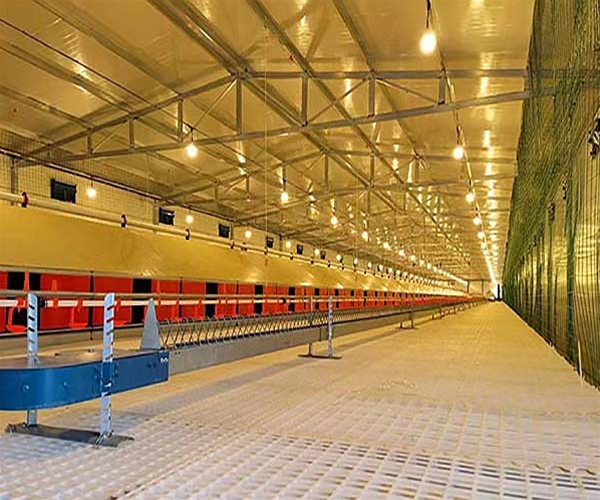Automatic poultry lighting system have become essential tools for optimizing egg production, enhancing chicken health, and improving overall farm efficiency. These systems leverage intelligent control technologies to adjust lighting based on chickens’ growth stages, environmental conditions, and specific needs. In this article, we explore how automatic poultry lighting systems work, their key advantages, and how they can help farmers create a more productive and sustainable farming operation.
How the Automatic Poultry Lighting System Works
The automatic poultry lighting system is designed to regulate the light intensity and timing, ensuring that chickens receive optimal lighting throughout their growth and production cycles. This system incorporates several key components, including LED lights, sensors, controllers, and timing systems. Here’s how it works:
- Sensors and Controllers: The system uses light sensors to monitor ambient lighting conditions in real time. These sensors automatically adjust light intensity and duration to meet the specific needs of the chickens, taking into account factors like age, season, and environmental changes.
- LED Lighting: Unlike traditional incandescent bulbs, the system typically uses energy-efficient LED lights, which offer multiple benefits. LED lights provide consistent illumination, consume less energy, and last longer than conventional lighting, making them ideal for large-scale poultry operations.
- Simulating Natural Light Cycles: One of the main features of this system is its ability to simulate natural light cycles. This helps maintain the chickens’ biological rhythms, which are crucial for promoting health and productivity. For example, during peak egg-laying periods, the system can extend light duration and increase intensity to mimic longer days, stimulating egg production.
- Red Light for Enhanced Egg Production: Research has shown that red light (wavelengths of 600-650 nm) plays a key role in enhancing egg production. Red light stimulates the reproductive system of hens, increasing ovulation and egg-laying frequency, leading to higher production levels.
Key Benefits of the Automatic Poultry Lighting System
The automatic poultry lighting system offers numerous advantages that benefit both the productivity and welfare of poultry. Below are some of the most important benefits:
1. Increased Egg Production
Proper lighting is essential for regulating egg production. Studies have shown that the right lighting cycles and intensity can significantly boost egg-laying rates in poultry. The automatic lighting system allows farmers to adjust lighting based on the chickens’ growth stages and seasonal changes, ensuring optimal conditions for egg production.
For instance, extending the light duration during peak laying periods mimics longer daylight hours, encouraging hens to lay more eggs. In addition, the use of red light at the appropriate times further stimulates the reproductive system, leading to increased egg production.
2. Energy Efficiency and Cost Savings
Energy costs are a major consideration for poultry farms, particularly those on a larger scale. The automatic lighting system is designed to use energy-efficient LED lights, which consume far less power than traditional incandescent or fluorescent lighting. LED lights also have a longer lifespan, which reduces maintenance and replacement costs.
Moreover, the system’s ability to regulate light intensity and duration ensures that energy is only used when necessary, allowing farmers to cut down on electricity usage and reduce overall operating costs.
3. Healthier Chickens
Proper lighting not only boosts productivity but also improves chicken health. Lighting is key to regulating chickens’ biological clocks, helping to reduce stress and improve overall welfare. Stress reduction is critical in poultry farming, as stressed birds are more susceptible to illness and reduced productivity.
By mimicking natural day-night cycles, the automatic lighting system helps maintain a stable environment, ensuring that chickens receive adequate rest during the dark periods and enough light during the day. This promotes better growth rates, reduced disease risk, and improved immune system function.
4. Simplified Farm Management
Manual lighting adjustments can be time-consuming and prone to errors, especially in large-scale poultry farms. The automatic poultry lighting system simplifies farm management by allowing farmers to control lighting remotely. With intelligent programming and automation, farmers can easily adjust lighting settings through a mobile app or a central control system, saving time and effort.
Furthermore, the system’s automation reduces the need for constant human intervention, allowing farm staff to focus on other important aspects of farm operations.
5. Sustainable and Eco-Friendly
As sustainability becomes increasingly important in agriculture, the automatic poultry lighting system offers a more eco-friendly solution. The system uses energy-efficient LED lights that consume less power, have a longer lifespan, and produce less heat, which helps reduce the environmental footprint of poultry farms.
In addition, the system optimizes lighting schedules based on the chickens’ needs, reducing energy waste and ensuring that lighting is only used when necessary. This contributes to more sustainable farming practices and helps farmers minimize their energy consumption.
Applications of the Automatic Poultry Lighting System
The automatic poultry lighting system is highly versatile and can be applied in various types of poultry farming operations, from small-scale family farms to large commercial facilities. Here are some key applications:
1. Commercial Poultry Farms
In large-scale poultry operations, where thousands of chickens are housed together, the automatic lighting system is invaluable for ensuring uniformity in lighting conditions. The system helps optimize lighting across large areas, ensuring that every chicken receives the right amount of light to maximize production and health.
2. Egg Production Farms
Egg production farms benefit greatly from automatic lighting systems that regulate light intensity and duration to stimulate egg-laying. By using red light during specific phases of egg production, farmers can increase the frequency of egg-laying and improve egg quality.
3. Broiler Farms
Broiler farms can also benefit from automatic poultry lighting systems by using light cycles to regulate growth and feed behavior. The system can adjust light conditions to reduce stress during critical growth periods, ensuring that broilers grow at a healthy rate and are ready for market quickly.
4. Integrated Farm Systems
As farm automation technology continues to advance, automatic poultry lighting systems are increasingly integrated with other automated systems such as feeding, temperature control, and ventilation. This creates a fully integrated farming solution that helps improve overall farm productivity and efficiency.
Conclusion:
An automatic poultry lighting system is a smart investment for any poultry farmer looking to increase egg production, improve chicken health, and reduce energy costs. By leveraging LED lights, intelligent controls, and red light technology, these systems provide a reliable and sustainable solution for modern poultry farming.
By simulating natural light cycles, maintaining optimal lighting conditions, and reducing manual labor, the system enhances farm productivity and sustainability. Whether you are running a small-scale farm or a large commercial poultry operation, investing in an automatic poultry lighting system will help improve efficiency and boost profitability in the long run.

